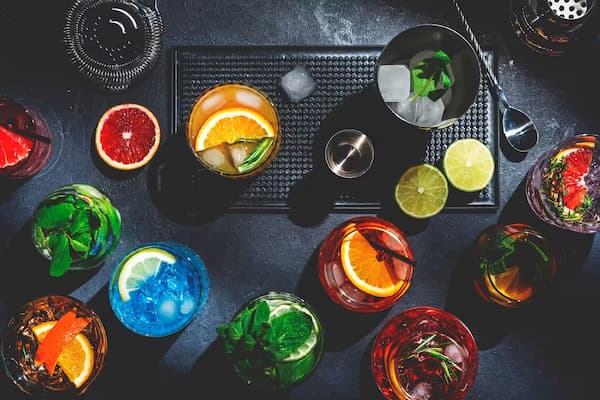Gin
With Gin you can make
Bold Negroni with a coffee twist.
Coffee Negroni
Gin, Campari, Red vermouth (Passed through a stove top coffee maker)
Floral elegance in every sip
Lavender French 75
Gin, Champagne / prosecco, Lemon Juice, Lavender Syrup
The ultimate bold cocktail experience
Aunt Roberta
Brandy, Vodka, Absinthe, Gin, Blackberry Liqueur
Exotic charm from the past
Pegu Club
Gin, Orange liqueur, Lime juice, Angostura Bitters
The Salted Sip Delight
Salty Dog
Gin, Grapefruit Juice, Salt
Timeless Italian sophistication
Negroni
Gin, Campari, Red vermouth
Sophistication in a glass.
San Martin
Gin, Yellow Chartreuse, Red vermouth
Crisp Sophistication in Every Sip
White Lady
Gin, Triple Sec, Lemon Juice
Unexpectedly Potent and Refreshing
Long Island Iced Tea
White rum, Gin, Tequila Blanco, Vodka, Cointreau, Cola, Lemon Juice, Sugar / simple Syrup
Sweet as honey, smooth as gin.
Bee's Knees
Gin, Lemon Juice, Honey syrup
Sophistication with a twist.
The Perfect Martini
Gin, Red vermouth, Olive Juice
We've got 11 cocktails that can be made with Gin.
Find out what to make with Gin
Q&A
What is the origin of gin?
Gin's origin can be traced back to the Middle Ages, with its predecessor spirits being used medicinally in Europe. The distillation process was refined in the 17th century in the Netherlands, where it was known as 'jenever.' British soldiers fighting in the Eighty Years' War appreciated its calming effects before battle, coining the term 'Dutch courage.' The spirit became popular in England, especially after the government allowed unlicensed gin production, leading to a period known as the Gin Craze in the 18th century.
What makes London Dry Gin different from other types of gin?
London Dry Gin is distinctive for its strict production methods and flavor profile. It must be distilled to a high degree of purity with all flavors, except water, added during the distillation process. No artificial flavors or colors can be added after distillation. This results in a high-quality, crisp, and dry gin with dominant juniper flavors, making it a favorite for classic cocktails like the Martini and Gin and Tonic.
How do you properly integrate gin into a cocktail?
Integrating gin into a cocktail requires balancing its botanical flavors with compatible mixers and ingredients. A well-made cocktail considers the type of gin being used. For aromatic gins, pairing with simple mixers like tonic water highlights its flavors. For more complex cocktails like Negronis or Martinis, using precise measurements ensures that the gin's character is well balanced with the vermouth, bitters, or other ingredients. Always start with quality ice and use proper stirring or shaking techniques as required by the recipe.
Is there a non-alcoholic substitute for gin in cocktails?
Yes, there are non-alcoholic substitutes for gin, known as 'alcohol-free spirits' or 'non-alcoholic gins.' These products mimic the botanical flavors of gin without using alcohol, using a blend of botanicals, herbs, and spices. They can be used in the same proportions as alcoholic gin in cocktails, offering a similar taste profile for those preferring non-alcoholic versions.
What is the best way to serve a gin-based cocktail?
The best way to serve a gin-based cocktail depends on the specific drink. For crisp, chilled drinks like a Martini, serving in a pre-chilled glass enhances its flavor. A Gin and Tonic is best served over ice in a highball glass with a wedge of lime or lemon to accentuate the gin's citrus notes. For a cocktail that’s more complex and aromatic, such as a Negroni, serving it over ice in an old-fashioned glass helps mellow the flavors and allows them to meld together. Garnishes play a key role in presentation and can add an extra layer of flavor.
Gin Brands
Ingredients like Gin
Other Gins
How it works
Easily create your bar from the ingredients you have at home, and we'll show you what you can make with the ingredients you have to hand.
Once you've added this ingredient head to your My bar page and fill up everything else you have.
We'll also show you cocktails that can make by substituting what you have for one of the ingredients you don't, riffing on the original. Now go forth and create something delicious!







